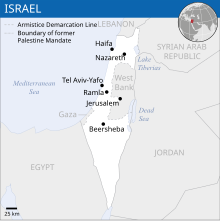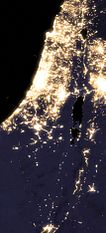
A | B | C | D | E | F | G | H | CH | I | J | K | L | M | N | O | P | Q | R | S | T | U | V | W | X | Y | Z | 0 | 1 | 2 | 3 | 4 | 5 | 6 | 7 | 8 | 9
State of Israel | |
|---|---|
| Anthem: הַתִּקְוָה (Hatīkvāh; "The Hope") | |
Israel within internationally recognized borders shown in dark green; Israeli-occupied territories shown in light green | |
| Capital and largest city | Jerusalem (limited recognition)[fn 1][fn 2] 31°47′N 35°13′E / 31.783°N 35.217°E |
| Official language | Hebrew[8] |
| Recognized language | Arabic[fn 3] |
| Ethnic groups (2023)[12] | |
| Religion (2016)[13] | |
| Demonym(s) | Israeli |
| Government | Unitary parliamentary republic |
| Isaac Herzog | |
| Benjamin Netanyahu | |
| Amir Ohana | |
| Uzi Vogelman (acting) | |
| Legislature | Knesset |
| Establishment | |
| 14 May 1948 | |
| 11 May 1949 | |
| 1958–2018 | |
| Area | |
• Total | 22,072 or 20,770[14][15] km2 (8,522 or 8,019 sq mi)[a] (149th) |
• Water (%) | 2.71[16] |
| Population | |
• 2024 estimate | 9,900,000[17] (93rd) |
• 2008 census | 7,412,200[18][fn 4] |
• Density | 449/km2 (1,162.9/sq mi) (29th) |
| GDP (PPP) | 2024 estimate |
• Total | |
• Per capita | |
| GDP (nominal) | 2024 estimate |
• Total | |
• Per capita | |
| Gini (2018) | 34.8[fn 4][20] medium |
| HDI (2022) | very high (25th) |
| Currency | New shekel (₪) (ILS) |
| Time zone | UTC+2:00 (IST) |
• Summer (DST) | UTC+3:00 (IDT) |
| Date format | |
| Driving side | right |
| Calling code | +972 |
| ISO 3166 code | IL |
| Internet TLD | .il |
| |
Israel,[a] officially the State of Israel,[b] is a country in the Southern Levant region of West Asia. It is bordered by Lebanon to the north, Syria to the northeast, Jordan to the east, the Red Sea to the south, Egypt to the southwest, the Mediterranean Sea to the west, and the Palestinian territories – the West Bank along the east and the Gaza Strip along the southwest.[22] Tel Aviv is the country's financial, economic, and technological center. Israel's governmental seat is in its proclaimed capital of Jerusalem, although recognition of Israeli sovereignty over East Jerusalem is limited internationally.[c][24]
Israel is located in a region known historically as Canaan, Palestine, and the Holy Land. In antiquity, it was home to several Canaanite, and later, Israelite and Judahite states, and is referred to as the Land of Israel in Jewish tradition. Situated at a continental crossroad, the region subsequently came under the rule of many different empires.[25] The late 19th century saw the rise of Zionism in Europe, a movement seeking a Jewish homeland, amid rising antisemitism in Europe, which garnered British support during World War I. During the war, British occupation led to the setting up of Mandatory Palestine in 1920. Increased Jewish immigration, combined with British colonial policy, led to intercommunal conflict between Jews and Arabs.[26][27] The 1947 UN Partition Plan triggered a civil war between the two groups, which saw the expulsion and flight of most of Mandatory Palestine's predominantly Arab population, known as the Nakba.[28][29][30] A minority remained and became Arab citizens of Israel.[31]
The State of Israel declared its establishment on 14 May 1948, the eve of the British termination of the Mandate. On 15 May 1948, the armies of neighboring Arab states invaded the area of former Mandatory Palestine, starting the First Arab–Israeli War. Primarily as a consequence of the war,[32][33] there was an influx of Jews, previously living in the North Africa and the Middle East, who were expelled or fled,[34] beginning a near total exodus of Jews living in the Muslim world.[35][36] The 1949 Armistice Agreements established Israel's borders over most of the former Mandate territory. The rest, the West Bank and the Gaza Strip, were taken by Jordan and Egypt respectively.[37][38][39] In the following years, Israel received many European Jews displaced during the Second World War. The 1967 Six-Day War saw Israel occupying the West Bank, Gaza Strip, Egyptian Sinai Peninsula and Syrian Golan Heights. The Israeli government has since established and continues to expand settlements across the occupied territories, actions which are deemed illegal under international law, and has annexed both East Jerusalem and the Golan Heights, actions which are largely unrecognized internationally. Since the 1973 Yom Kippur War, Israel has signed peace treaties with Egypt, returning the Sinai Peninsula, and with Jordan, and has more recently normalized relations with several Arab countries. However, international efforts to resolve the Israeli–Palestinian conflict have not succeeded. Israel's practices in its occupation of the Palestinian territories have drawn sustained international criticism. It has been accused of committing war crimes and crimes against humanity, including the crime of apartheid, against the Palestinian people by human rights organizations and United Nations officials.
The country has a parliamentary system elected by proportional representation. The prime minister serves as head of government, and is elected by the Knesset, Israel's unicameral legislature.[40] Israel has one of the biggest economies in the Middle East by nominal GDP,[41] it is one of the richest countries in the Middle East and Asia,[42][43][44] and an OECD member since 2010.[45] It has one of the highest standards of living in the Middle East and Asia, and has been ranked as one of the most advanced and technological countries.[46][47][48] Israel has a population of nearly 10 million people as of 2023[update].[49][19]
Etymology
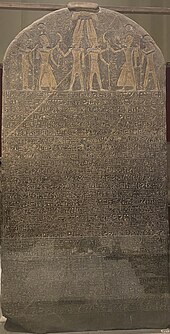
Under the British Mandate (1920–1948), the whole region was known as Palestine.[50] Upon establishment in 1948, the country formally adopted the name State of Israel (Hebrew: מְדִינַת יִשְׂרָאֵל, [mediˈnat jisʁaˈʔel]; Arabic: دَوْلَة إِسْرَائِيل, Dawlat Isrāʼīl, [dawlat ʔisraːˈʔiːl]) after other proposed names including Land of Israel (Eretz Israel), Ever (from ancestor Eber), Zion, and Judea, were considered but rejected.[51] The name Israel was suggested by Ben-Gurion and passed by a vote of 6–3.[52] In the early weeks after establishment, the government chose the term Israeli to denote a citizen of the Israeli state.[53]
The names Land of Israel and Children of Israel have historically been used to refer to the biblical Kingdom of Israel and the entire Jewish people respectively.[54] The name 'Israel' (Hebrew: Yīsrāʾēl; Septuagint Greek: Ἰσραήλ, Israēl, 'El (God) persists/rules', though after Hosea 12:4 often interpreted as 'struggle with God') refers to the patriarch Jacob who, according to the Hebrew Bible, was given the name after he successfully wrestled with the angel of the Lord.[55] The earliest known archaeological artefact to mention the word Israel as a collective is the Merneptah Stele of ancient Egypt (dated to the late 13th century BCE).[56]
History
Early expansions of hominins out of Africa into the Levant, where Israel is located, dates back at least 1.5 million years based on traces found at the Ubeidiya prehistoric site.[57] The Skhul and Qafzeh hominins, dating back 120,000 years, are some of the earliest traces of anatomically modern humans outside of Africa.[58] The Natufian culture emerged in the southern Levant by the 10th millennium BCE,[59] followed by the Ghassulian culture by around 4,500 BCE.[60]
Bronze and Iron Ages
Early references to "Canaanites" and "Canaan" appear in Near Eastern and Egyptian texts (c. 2000 BCE); these populations were structured as politically independent, territorially based city-states.[61][62] During the Late Bronze Age (1550–1200 BCE), large parts of Canaan formed vassal states paying tribute to the New Kingdom of Egypt.[63] As a result of the Late Bronze Age collapse, Canaan fell into chaos, and Egyptian control over the region collapsed.[64][65]
A people named Israel appear for the first time in the Merneptah Stele, an ancient Egyptian inscription which dates to about 1200 BCE.[66][67][fn 5][69] Ancestors of the Israelites are thought to have included ancient Semitic-speaking peoples native to this area.[70]: 78–79 Modern archaeological accounts suggest that the Israelites and their culture branched out of the Canaanite peoples[71] through the development of a distinct monolatristic—and later monotheistic—religion centered on Yahweh.[72][73] They spoke an archaic form of Hebrew, known as Biblical Hebrew.[74] Around the same time, the Philistines settled on the southern coastal plain.[75][76]
Modern archaeology has largely discarded the historicity of the narrative in the Torah concerning the patriarchs, The Exodus and the tales of conquest in the Book of Joshua, and instead views the narrative as the Israelites' national myth.[77] However, some elements of these traditions do appear to have historical roots.[78][79][80]
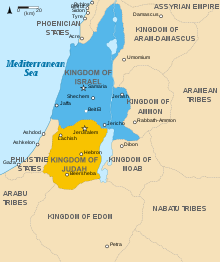
There is debate about the earliest existence of the Kingdoms of Israel and Judah and their extent and power. While it is unclear if there was ever a United Kingdom of Israel,[81][82] historians and archaeologists agree that the northern Kingdom of Israel existed by ca. 900 BCE[83]: 169–195 [84] and the Kingdom of Judah by ca. 850 BCE.[85][86] The Kingdom of Israel was the more prosperous of the two and soon developed into a regional power;[87] during the Omride dynasty, it controlled Samaria, Galilee, the upper Jordan Valley, the Sharon and large parts of the Transjordan.[88] Samaria, the capital, was home to one of the largest Iron Age structures in the Levant.[89][90]
The Kingdom of Israel was destroyed around 720 BCE, when it was conquered by the Neo-Assyrian Empire.[91] The Kingdom of Judah, with its capital in Jerusalem, later became a client state of first the Neo-Assyrian Empire and then the Neo-Babylonian Empire. It is estimated that the region's population was around 400,000 in the Iron Age II.[92] In 587/6 BCE, following a revolt in Judah, King Nebuchadnezzar II besieged and destroyed Jerusalem and Solomon's Temple,[93][94] dissolved the kingdom and exiled much of the Judean elite to Babylon, beginning the Babylonian captivity.[95] The defeat was recorded in the Babylonian Chronicles.[96][97] After capturing Babylon in 539 BCE, Cyrus the Great, founder of the Achaemenid Empire, issued a proclamation allowing the exiled Judean population to return to Judah.[98][99]
Classical antiquity
The construction of the Second Temple was completed c. 520 BCE.[98] The Achaemenids ruled the region as the province of Yehud Medinata,[100] which had a population of around 30,000 in the 5th to 4th centuries BCE.[83]: 308
In 332 BCE, Alexander the Great of Macedon conquered the region as part of his campaign against the Achaemenid Empire. After his death, the area was controlled by the Ptolemaic and Seleucid empires as a part of Coele-Syria. Over the ensuing centuries, the Hellenization of the region led to cultural tensions that came to a head during the reign of Antiochus IV, giving rise to the Maccabean Revolt of 167 BCE. The civil unrest weakened Seleucid rule and in the late 2nd century the semi-autonomous Hasmonean Kingdom of Judea arose, eventually attaining full independence and expanding into neighboring regions.[101][102][103]

The Roman Republic invaded the region in 63 BCE, first taking control of Syria, and then intervening in the Hasmonean Civil War. The struggle between pro-Roman and pro-Parthian factions in Judea led to the installation of Herod the Great as a dynastic vassal of Rome. In 6 CE, the area was annexed as the Roman province of Judaea; tensions with Roman rule led to a series of Jewish–Roman wars, resulting in widespread destruction. The First Jewish–Roman War (66–73 CE) resulted in the destruction of Jerusalem and the Second Temple and a sizable portion of the population being killed or displaced.[104]
A second uprising known as the Bar Kokhba revolt took place during 132–136 CE. Initial successes allowed the Jews to form an independent state, but the Romans massed large forces and brutally crushed the rebellion, devastating and depopulating Judea's countryside.[104][105][106][107][108] Jerusalem was rebuilt as a Roman colony (Aelia Capitolina), and the province of Judea was renamed Syria Palaestina.[109][110] Jews were expelled from the districts surrounding Jerusalem,[111][107] and joined communities in the diaspora.[112] Nevertheless, there was a continuous small Jewish presence and Galilee became its religious center.[113][114] Jewish communities also continued to reside in the southern Hebron Hills and on the coastal plain.[107]
Late antiquity and the medieval period

With the transition to Byzantine rule under Emperor Constantine, Early Christianity displaced the more tolerant Roman Paganism.[116][117] With the conversion of Constantine in the 4th century, the situation for the Jewish majority in Palestine "became more difficult".[112] A series of laws were passed that discriminated against Jews and Judaism, and Jews were persecuted by both the church and the authorities.[117] Many Jews had emigrated to flourishing Diaspora communities,[118] while locally there was both Christian immigration and local conversion. By the middle of the 5th century, there was a Christian majority.[119][120] Towards the end of the 5th century, Samaritan revolts erupted, continuing until the late 6th century and resulting in a large decrease in the Samaritan population.[121] After the Sasanian conquest of Jerusalem and the short-lived Jewish revolt against Heraclius in 614 CE, the Byzantine Empire reconsolidated control of the area in 628.[122]
In 634–641 CE, the Rashidun Caliphate conquered the Levant.[118][123][124] Over the next six centuries, control of the region transferred between the Umayyad, Abbasid, Fatimid caliphates, and subsequently the Seljuks and Ayyubid dynasties.[125] The population drastically decreased during the following several centuries, dropping from an estimated 1 million during Roman and Byzantine periods to about 300,000 by the early Ottoman period, and there was a steady process of Arabization and Islamization brought on by non-Muslim emigration, Muslim immigration, seeking economic prosperity, and local conversion.[124][123][126][92][127] The end of the 11th century brought the Crusades, papally-sanctioned incursions of Christian crusaders intent on wresting Jerusalem and the Holy Land from Muslim control and establishing Crusader States.[128] The Ayyubids pushed back the crusaders before Muslim rule was fully restored by the Mamluk sultans of Egypt in 1291.[129]
Modern period and the emergence of Zionism

In 1516, the Ottoman Empire conquered the region and ruled it as part of Ottoman Syria for the next four centuries.[130] Under the Ottoman Empire, the Levant was fairly cosmopolitan, with religious freedoms for Christians, Muslims, and Jews. In 1561 the Ottoman sultan invited Sephardi Jews escaping the Spanish Inquisition to settle in and rebuild the city of Tiberias.[131][132] Although the status of the Jews in the Ottoman Empire may have been exaggerated,[133] it is undeniable that some tolerance was enjoyed. There were no restrictions in the professions Jews could practice.[134] There were restrictions, however, regarding areas Jews could live in or work, similar to the restrictions placed on Ottoman subjects of other religions.[135] All non-Muslims had to pay the haraç ("head tax") and faced restrictions in clothing, horse riding, army service, residence location, slave ownership, etc. Although many of these restrictions were decreed, they were not always enforced.[136][137] Jizya collected from Christian and Jewish communities was among the main sources of tax income of the Ottoman treasury.[138] Under the millet system, non-Muslims were organized as autonomous communities on the basis of religion.[134] The population of Jerusalem was divided into four major communities – Jewish, Christian, Muslim, and Armenian. The first three of these could be further divided into subgroups, based on religious affiliation or country of origin. Each quarter of Safed was named for its inhabitants' place of origin: Purtuqal (Portugal), Qurtubah (Cordoba), Qastiliyah (Castille), Musta'rib (Musta'arabi Jews), Magharibah (Maghreb), Araghun ma' Qatalan (Aragon and Catalonia), Majar (Hungary), Puliah (Apulia), Qalabriyah (Calabria), Sibiliyah (Seville), Taliyan (Italian) and Alaman (German).[139]

Since the existence of the Jewish diaspora, many Jews have aspired to return to "Zion".[140] The Jewish population of Palestine from the Ottoman rule to the beginning of the Zionist movement, known as the Old Yishuv, comprised a minority and fluctuated in size. During the 16th century, Jewish communities struck roots in the Four Holy Cities—Jerusalem, Tiberias, Hebron, and Safed—and in 1697, Rabbi Yehuda Hachasid led a group of 1,500 Jews to Jerusalem.[141] A 1660 Druze revolt against the Ottomans destroyed Safed and Tiberias.[130] In the second half of the 18th century, Eastern European Jews who were opponents of Hasidism, known as the Perushim, settled in Palestine.[142][143]
In the late 18th century, local Arab Sheikh Zahir al-Umar created a de facto independent Emirate in the Galilee. Ottoman attempts to subdue the Sheikh failed. After Zahir's death the Ottomans regained control of the area. In 1799, governor Jazzar Pasha repelled an assault on Acre by Napoleon's troops, prompting the French to abandon the Syrian campaign.[144] In 1834, a revolt by Palestinian Arab peasants against Egyptian conscription and taxation policies under Muhammad Ali was suppressed; Muhammad Ali's army retreated and Ottoman rule was restored with British support in 1840.[145] Afterwards, the Tanzimat reforms were implemented across the Ottoman Empire.
The first wave of modern Jewish migration to Ottoman-ruled Palestine, known as the First Aliyah, began in 1881, as Jews fled pogroms in Eastern Europe.[146] The 1882 May Laws increased economic discrimination against Jews, and restricted where they could live.[147][148] In response, political Zionism took form. Some of its activists founded movements such as the Bilu and Lovers of Zion. Leon Pinsker published the pamphlet Auto-Emancipation (1882), which urged Jews to seek national independence.[149][150] Theodor Herzl is credited with founding political Zionism,[151] a movement that sought to establish a Jewish state in the Land of Israel, thus offering a solution to the Jewish question of the European states.[152] In 1896, Herzl published Der Judenstaat (The Jewish State); the following year he presided over the First Zionist Congress.[153] The Second Aliyah (1904–1914) began after the Kishinev pogrom; some 40,000 Jews settled in Palestine, although nearly half left eventually. Both the first and second waves of migrants were mainly Orthodox Jews.[154] The Second Aliyah included Zionist socialist groups who established the kibbutz movement based on the idea of establishing a separate Jewish economy based exclusively on Jewish labor.[155][156] Those of the Second Aliyah who became leaders of the Yishuv in the coming decades believed that the Jewish settler economy should not depend on Arab labor. This would be a dominant source of antagonism with the Arab population, with the new Yishuv's nationalist ideology overpowering its socialist one.[157] Though the immigrants of the Second Aliyah largely sought to create communal Jewish agricultural settlements, Tel Aviv was established as the first planned Jewish town in 1909. Jewish armed militias emerged during this period, the first being Bar-Giora in 1907. Two years later, the larger Hashomer organization was founded as its replacement.
British Mandate for Palestine
Chaim Weizmann's efforts to garner British support for the Zionist movement eventually secured the Balfour Declaration in 1917.[158] British Foreign Secretary Arthur Balfour sent the Balfour Declaration to Lord Rothschild, a leader of the British Jewish community, stating Britain's support for the creation of a Jewish "national home" in Palestine.[159][160] Weizmann interpretation of the declaration entailed that negotiations on the future of the country were to happen directly between Britain and the Jews, excluding Arab representation. His announcement at the Paris peace conference would reflect this interpretation, stating that the goal "o make Palestine as Jewish as England is English." The years that followed would see Jewish-Arab relations in Palestine deteriorate dramatically.[161]
In 1918, the Jewish Legion, a group primarily of Zionist volunteers, assisted in the British conquest of Palestine.[162] In 1920, the territory was divided between Britain and France under the mandate system, and the British-administered area (including modern Israel) was named Mandatory Palestine.[129][163][164] Arab opposition to British rule and Jewish immigration led to the 1920 Palestine riots and the formation of a Jewish militia known as the Haganah ("The Defense") as an outgrowth of Hashomer, from which the Irgun and Lehi paramilitaries later split.[165] In 1922, the League of Nations granted Britain the Mandate for Palestine under terms which included the Balfour Declaration with its promise to the Jews, and with similar provisions regarding the Arab Palestinians.[166] The population of the area was predominantly Arab and Muslim, with Jews accounting for about 11%,[167] and Arab Christians about 9.5% of the population.[168] Malaria in Palestine was a challenge facing early Jewish settlers.[169]
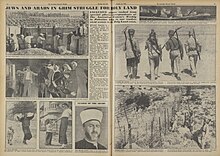
The Third (1919–1923) and Fourth Aliyahs (1924–1929) brought an additional 100,000 Jews to Palestine. The rise of Nazism and the increasing persecution of Jews in 1930s Europe led to the Fifth Aliyah, with an influx of a quarter of a million Jews. This was a major cause of the Arab revolt of 1936–39. The revolt, which involved significant intercommunal fighting among the Arabs,[170] was suppressed by British security forces and Zionist militias. Several hundred British security personnel and Jews were killed. 5,032 Arabs were killed, 14,760 were wounded, and 12,622 were detained.[171][172][173] An estimated ten percent of the adult male Palestinian Arab population was killed, wounded, imprisoned or exiled.[174]
The British introduced restrictions on Jewish immigration to Palestine with the White Paper of 1939. With countries around the world turning away Jewish refugees fleeing the Holocaust, a clandestine movement known as Aliyah Bet, was organized to bring Jews to Palestine. By the end of World War II, 31% of the total population of Palestine was Jewish.[175] The UK found itself facing a Jewish insurgency over immigration restrictions and continued conflict with the Arab community over limit levels. The Haganah joined Irgun and Lehi in an armed struggle against British rule.[176] At the same time, hundreds of thousands of Jewish Holocaust survivors sought a new life far from their destroyed communities in Europe. The Haganah attempted to bring tens of thousands of Jewish refugees to Palestine by ship in a programme called Aliyah Bet. Most of the ships were intercepted by the Royal Navy and the refugees placed in detention camps in Atlit and Cyprus.[177][178]

On 22 July 1946, Irgun bombed the British administrative headquarters for Palestine, killing 91.[179][180][181][182][183][184] The attack initially had the approval of the Haganah. It was a response to Operation Agatha (a series of raids, including one on the Jewish Agency, by the British) and was the deadliest directed at the British during the Mandate era.[183][184] The Jewish insurgency continued throughout 1946 and 1947 despite concerted efforts by the British military and Palestine Police Force to suppress it. British efforts to mediate a negotiated solution with Jewish and Arab representatives also failed as the Jews were unwilling to accept any solution that did not involve a Jewish state and suggested a partition of Palestine into Jewish and Arab states, while the Arabs were adamant that a Jewish state in any part of Palestine was unacceptable and that the only solution was a unified Palestine under Arab rule. In February 1947, the British referred the Palestine issue to the newly formed United Nations. On 15 May 1947, the UN General Assembly resolved that a Special Committee be created "to prepare ... a report on the question of Palestine."[185] The Report of the Committee[186] proposed a plan to replace the British Mandate with "an independent Arab State, an independent Jewish State, and the City of Jerusalem the last to be under an International Trusteeship System."[187] Meanwhile, the Jewish insurgency continued and peaked in July 1947, with a series of widespread guerrilla raids culminating in the Sergeants affair, in which the Irgun took two British sergeants hostage as attempted leverage against the planned execution of three Irgun operatives. After the executions were carried out, the Irgun killed the two British soldiers, hanged their bodies from trees, and left a booby trap at the scene which injured a British soldier. The incident caused widespread outrage in the UK.[188] In September 1947, the British cabinet decided to evacuate Palestine as the Mandate was no longer tenable.[188]
On 29 November 1947, the General Assembly adopted Resolution 181 (II).[189] The plan attached to the resolution was essentially that proposed in the report of 3 September. The Jewish Agency, the recognized representative of the Jewish community, accepted the plan, which assigned 55–56% of Mandatory Palestine to the Jews. At the time, the Jews were about a third of the population and owned around 6–7% of the land. Arabs constituted the majority and owned about 20% of the land, with the remainder held by the Mandate authorities or foreign landowners.[190][191][192][193][194][195][196] The Arab League and Arab Higher Committee of Palestine rejected it,[197] and indicated that they would reject any other plan of partition.[198][199] On 1 December 1947, the Arab Higher Committee proclaimed a three-day strike, and riots broke out in Jerusalem.[200] The situation spiraled into a civil war; just two weeks after the UN vote, Colonial Secretary Arthur Creech Jones announced that the British Mandate would end on 15 May 1948, at which point the British would evacuate. As Arab militias and gangs attacked Jewish areas, they were faced mainly by the Haganah, as well as the smaller Irgun and Lehi. In April 1948, the Haganah moved onto the offensive.[201][202] During this period 250,000 Palestinian Arabs fled or were expelled, due to numerous factors.[203]
State of Israel
Establishment and early years

On 14 May 1948, the day before the expiration of the British Mandate, David Ben-Gurion, the head of the Jewish Agency, declared "the establishment of a Jewish state in Eretz-Israel, to be known as the State of Israel."[204] The only reference in the text of the Declaration to the borders of the new state is the use of the term Eretz-Israel ("Land of Israel").[citation needed] The following day, the armies of four Arab countries—Egypt, Syria, Transjordan and Iraq—entered into parts of what had been British Mandatory Palestine, launching the 1948 Arab–Israeli War;[205][206][207] contingents from Yemen, Morocco, Saudi Arabia and Sudan joined the war.[208][209] The apparent purpose of the invasion was to prevent the establishment of the Jewish state; some Arab leaders talked about "driving the Jews into the sea".[195][210][211] According to Benny Morris, Jews were worried that the invading Arab armies held the intent to slaughter them.[212] The Arab league stated the invasion was to restore order and prevent further bloodshed.[213]
After a year of fighting, a ceasefire was declared and temporary borders, known as the Green Line, were established.[214] Jordan annexed what became known as the West Bank, including East Jerusalem, and Egypt occupied the Gaza Strip. Over 700,000 Palestinians were expelled by or fled by Zionist militias and the Israeli military—what would become known in Arabic as the Nakba ("catastrophe").[215] The events also led to the destruction of most of Palestine's predominantly Arab population's society, culture, identity, political rights, and national aspirations. Some 156,000 remained and became Arab citizens of Israel.[31]

Israel was admitted as a member of the UN on 11 May 1949.[216] An Israeli-Jordanian attempt at negotiating a peace agreement broke down after the British government, fearful of the Egyptian reaction to such a treaty, expressed their opposition to the Jordanian government.[217] In the early years of the state, the Labor Zionist movement led by Prime Minister David Ben-Gurion dominated Israeli politics.[218][219]
Immigration to Israel during the late 1940s and early 1950s was aided by the Israeli Immigration Department and the non-government sponsored Mossad LeAliyah Bet (lit. "Institute for Immigration B").[220] The latter engaged in clandestine operations in countries, particularly in the Middle East and Eastern Europe, where the lives of Jews were believed to be in danger and exit was difficult. Mossad LeAliyah Bet was disbanded in 1953.[221] The immigration was in accordance with the One Million Plan. Some immigrants held Zionist beliefs or came for the promise of a better life, while others moved to escape persecution or were expelled.[222][223]
An influx of Holocaust survivors and Jews from Arab and Muslim countries to Israel during the first three years increased the number of Jews from 700,000 to 1,400,000. By 1958, the population had risen to two million.[224] Between 1948 and 1970, approximately 1,150,000 Jewish refugees relocated to Israel.[225] Some new immigrants arrived as refugees and were housed in temporary camps known as ma'abarot; by 1952, over 200,000 people were living in these tent cities.[226] Jews of European background were often treated more favorably than Jews from Middle Eastern and North African countries—housing units reserved for the latter were often re-designated for the former, so Jews newly arrived from Arab lands generally ended up staying longer in transit camps.[227][228] During this period, food, clothes and furniture were rationed in what became known as the austerity period. The need to solve the crisis led Ben-Gurion to sign a reparations agreement with West Germany that triggered mass protests by Jews angered at the idea that Israel could accept monetary compensation for the Holocaust.[229]
Arab–Israeli conflict
During the 1950s, Israel was frequently attacked by Palestinian fedayeen, nearly always against civilians,[230] mainly from the Egyptian-occupied Gaza Strip,[231] leading to several Israeli reprisal operations. In 1956, the UK and France aimed at regaining control of the Suez Canal, which Egypt had nationalized. The continued blockade of the Suez Canal and Straits of Tiran to Israeli shipping, together with increasing Fedayeen attacks against Israel's southern population and recent Arab threatening statements, prompted Israel to attack Egypt.[232][233][234] Israel joined a secret alliance with the UK and France and overran the Sinai Peninsula in the Suez Crisis, but was pressured to withdraw by the UN in return for guarantees of Israeli shipping rights.[235][236][237] The war resulted in significant reduction of Israeli border infiltration.[238]
In the early 1960s, Israel captured Nazi war criminal Adolf Eichmann in Argentina and brought him to Israel for trial.[239] Eichmann remains the only person executed in Israel by conviction in an Israeli civilian court.[240] During the spring and summer of 1963 Israel was engaged in a diplomatic standoff with the United States due to the Israeli nuclear programme.[241][242]
Since 1964, Arab countries, concerned over Israeli plans to divert waters of the Jordan River into the coastal plain,[243] had been trying to divert the headwaters to deprive Israel of water resources, provoking tensions between Israel on the one hand, and Syria and Lebanon on the other. Arab nationalists led by Egyptian President Gamal Abdel Nasser refused to recognize Israel and called for its destruction.[244][245][246] By 1966, Israeli-Arab relations had deteriorated to the point of battles taking place between Israeli and Arab forces.[247]
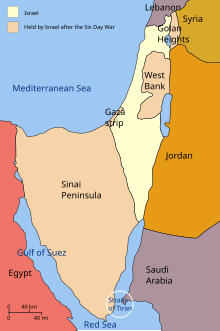
In May 1967, Egypt massed its army near the border with Israel, expelled UN peacekeepers, stationed in the Sinai Peninsula since 1957, and blocked Israel's access to the Red Sea.[248][249][250] Other Arab states mobilized their forces.[251] Israel reiterated that these actions were a casus belli and launched a pre-emptive strike against Egypt in June. Jordan, Syria and Iraq attacked Israel. In the Six-Day War, Israel captured and occupied the West Bank from Jordan, the Gaza Strip and Sinai Peninsula from Egypt, and the Golan Heights from Syria.[252] Jerusalem's boundaries were enlarged, incorporating East Jerusalem. The 1949 Green Line became the administrative boundary between Israel and the occupied territories.[253]
Following the 1967 war and the "Three Nos" resolution of the Arab League, Israel faced attacks from the Egyptians in the Sinai Peninsula during the 1967–1970 War of Attrition, and from Palestinian groups targeting Israelis in the occupied territories, globally, and in Israel. Most important among the Palestinian and Arab groups was the Palestinian Liberation Organization (PLO), established in 1964, which initially committed itself to "armed struggle as the only way to liberate the homeland".[254] In the late 1960s and early 1970s, Palestinian groups launched attacks[255][256] against Israeli and Jewish targets around the world,[257] including a massacre of Israeli athletes at the 1972 Summer Olympics in Munich. The Israeli government responded with an assassination campaign against the organizers of the massacre, a bombing and a raid on the PLO headquarters in Lebanon.
On 6 October 1973, the Egyptian and Syrian armies launched a surprise attack against Israeli forces in the Sinai Peninsula and Golan Heights, opening the Yom Kippur War. The war ended on 25 October with Israel repelling Egyptian and Syrian forces but suffering great losses.[258] An internal inquiry exonerated the government of responsibility for failures before and during the war, but public anger forced Prime Minister Golda Meir to resign.[259][better source needed] In July 1976, an airliner was hijacked in flight from Israel to France by Palestinian guerrillas and landed at Entebbe International Airport, Uganda. Israeli commandos rescued 102 out of 106 Israeli hostages.
Peace process
The 1977 Knesset elections marked a major turning point in Israeli political history as Menachem Begin's Likud party took control from the Labor Party.[260] Later that year, Egyptian President Anwar El Sadat made a trip to Israel and spoke before the Knesset in what was the first recognition of Israel by an Arab head of state.[261] Sadat and Begin signed the Camp David Accords (1978) and the Egypt–Israel peace treaty (1979).[262] In return, Israel withdrew from the Sinai Peninsula and agreed to enter negotiations over an autonomy for Palestinians in the West Bank and the Gaza Strip.[262]
On 11 March 1978, a PLO guerilla raid from Lebanon led to the Coastal Road massacre. Israel responded by launching an invasion of southern Lebanon to destroy PLO bases. Most PLO fighters withdrew, but Israel was able to secure southern Lebanon until a UN force and the Lebanese army could take over. The PLO soon resumed its insurgency against Israel. In the next few years, the PLO infiltrated the south and kept up a sporadic shelling across the border. Israel carried out numerous retaliatory attacks.
Meanwhile, Begin's government provided incentives for Israelis to settle in the occupied West Bank, increasing friction with the Palestinians there.[263] The Jerusalem Law (1980) was believed by some to reaffirm Israel's 1967 annexation of Jerusalem by government decree, and reignited international controversy over the status of the city. No Israeli legislation has defined the territory of Israel and no act specifically included East Jerusalem therein.[264] In 1981 Israel effectively annexed the Golan Heights.[265] The international community largely rejected these moves, with the UN Security Council declaring both the Jerusalem Law and the Golan Heights Law null and void.[266][267] Several waves of Ethiopian Jews immigrated to Israel since the 1980s, while between 1990 and 1994, immigration from the post-Soviet states increased Israel's population by twelve percent.[268]
On 7 June 1981, during the Iran–Iraq War, the Israeli air force destroyed Iraq's sole nuclear reactor under construction just outside Baghdad, to impede Iraq's nuclear weapons programme. Following a series of PLO attacks in 1982, Israel invaded Lebanon to destroy the PLO bases.[269] In the first six days, the Israelis destroyed the military forces of the PLO in Lebanon and decisively defeated the Syrians. An Israeli government inquiry (the Kahan Commission) held Begin and several Israeli generals indirectly responsible for the Sabra and Shatila massacre and held Defense minister Ariel Sharon as bearing "personal responsibility".[270] Sharon was forced to resign.[271] In 1985, Israel responded to a Palestinian terrorist attack in Cyprus by bombing the PLO headquarters in Tunisia. Israel withdrew from most of Lebanon in 1986, but maintained a borderland buffer zone in southern Lebanon until 2000, from where Israeli forces engaged in conflict with Hezbollah. The First Intifada, a Palestinian uprising against Israeli rule,[272] broke out in 1987, with waves of uncoordinated demonstrations and violence in the occupied West Bank and Gaza. Over the following six years, the Intifada became more organized and included economic and cultural measures aimed at disrupting the Israeli occupation. Over a thousand people were killed.[273] During the 1991 Gulf War, the PLO supported Saddam Hussein and Iraqi missile attacks against Israel. Despite public outrage, Israel heeded American calls to refrain from hitting back.[274][275]
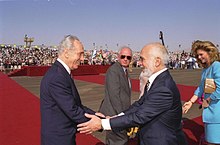
In 1992, Yitzhak Rabin became prime minister following an election in which his party called for compromise with Israel's neighbours.[276][277] The following year, Shimon Peres on behalf of Israel, and Mahmoud Abbas for the PLO, signed the Oslo Accords, which gave the Palestinian National Authority (PNA) the right to govern parts of the West Bank and the Gaza Strip.[278] The PLO also recognized Israel's right to exist and pledged an end to terrorism.[279][better source needed] In 1994, the Israel–Jordan peace treaty was signed, making Jordan the second Arab country to normalize relations with Israel.[280] Arab public support for the Accords was damaged by the continuation of Israeli settlements[281] and checkpoints, and the deterioration of economic conditions.[282] Israeli public support for the Accords waned after Palestinian suicide attacks.[283] In November 1995, Yitzhak Rabin was assassinated by Yigal Amir, a far-right Jew who opposed the Accords.[284]
During Benjamin Netanyahu's premiership at the end of the 1990s, Israel agreed to withdraw from Hebron,[285] though this was never ratified or implemented,[286] and signed the Wye River Memorandum, giving greater control to the PNA.[287] Ehud Barak, elected Prime Minister in 1999, withdrew forces from Southern Lebanon and conducted negotiations with PNA Chairman Yasser Arafat and U.S. President Bill Clinton at the 2000 Camp David Summit. Barak offered a plan for the establishment of a Palestinian state, including the entirety of the Gaza Strip and over 90% of the West Bank with Jerusalem as a shared capital.[288] Each side blamed the other for the failure of the talks.
21st century
This section needs to be updated. The reason given is: the events of the last two decades outside of conflict is barely covered. (March 2023) |

In late 2000, after a controversial visit by Likud leader Ariel Sharon to the Temple Mount, the Second Intifada began and continued for the next 4.5 years. Suicide bombings were a recurrent feature of the Intifada.[290] Some commentators contend that the Intifada was pre-planned by Arafat due to the collapse of peace talks.[291][292][293][294] Sharon became prime minister in a 2001 election; he carried out his plan to unilaterally withdraw from the Gaza Strip and spearheaded the construction of the Israeli West Bank barrier,[295] ending the Intifada.[296] Between 2000 and 2008, 1,063 Israelis, 5,517 Palestinians and 64 foreign citizens had been killed.[297]
In 2006, a Hezbollah artillery assault on Israel's northern border communities and a cross-border abduction of two Israeli soldiers precipitated the month-long Second Lebanon War.[298][299] In 2007, the Israeli Air Force destroyed a nuclear reactor in Syria. In 2008, a ceasefire between Hamas and Israel collapsed. The 2008–2009 Gaza War lasted three weeks and ended after Israel announced a unilateral ceasefire.[300][301] Hamas announced its own ceasefire, with its own conditions of complete withdrawal and opening of border crossings. Despite neither the rocket launchings nor Israeli retaliatory strikes having completely stopped, the fragile ceasefire remained.[302] In what Israel described as a response to over a hundred Palestinian rocket attacks on southern Israeli cities,[303] Israel began an operation in the Gaza Strip in 2012, lasting eight days.[304] Israel started another operation in Gaza following an escalation of rocket attacks by Hamas in July 2014.[305] In May 2021, another round of fighting took place in Gaza and Israel, lasting eleven days.[306]
By the 2010s, increasing regional cooperation between Israel and Arab League countries have been established, culminating in the signing of the Abraham Accords. The Israeli security situation shifted from the traditional Arab–Israeli conflict towards the Iran–Israel proxy conflict and direct confrontation with Iran during the Syrian civil war. On 7 October 2023, Palestinian militant groups from Gaza, led by Hamas, launched a series of coordinated attacks on Israel, leading to the start of the Israel–Hamas war.[307] On that day, approximately 1300 Israelis, predominantly civilians, were killed in communities near the Gaza Strip border and during a music festival. Over 200 hostages, including elders, women, and children as young as 9 months, were kidnapped and taken to the Gaza Strip.[308][309][310]
Geography
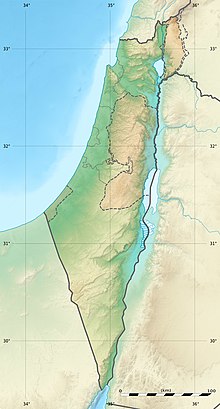
Israel is located in the Levant area of the Fertile Crescent. The country is at the eastern end of the Mediterranean Sea, bounded by Lebanon to the north, Syria to the northeast, Jordan and the West Bank to the east, and Egypt and the Gaza Strip to the southwest. It lies between latitudes 29° and 34° N, and longitudes 34° and 36° E.
The sovereign territory of Israel (according to the demarcation lines of the 1949 Armistice Agreements and excluding all territories captured by Israel during the 1967 Six-Day War) is approximately 20,770 square kilometers (8,019 sq mi), of which two percent is water.[311] However Israel is so narrow (100 km at its widest, compared to 400 km from north to south) that the exclusive economic zone in the Mediterranean is double the land area of the country.[312] The total area under Israeli law, including East Jerusalem and the Golan Heights, is 22,072 square kilometers (8,522 sq mi),[313] and the total area under Israeli control, including the military-controlled and partially Palestinian-governed territory of the West Bank, is 27,799 square kilometers (10,733 sq mi).[314]
Despite its small size, Israel is home to a variety of geographic features, from the Negev desert in the south to the inland fertile Jezreel Valley, mountain ranges of the Galilee, Carmel and toward the Golan in the north. The Israeli coastal plain on the shores of the Mediterranean is home to most of the nation's population.[315] East of the central highlands lies the Jordan Rift Valley, a small part of the 6,500-kilometer (4,039 mi) Great Rift Valley. The Jordan River runs along the Jordan Rift Valley, from Mount Hermon through the Hulah Valley and the Sea of Galilee to the Dead Sea, the lowest point on the surface of the Earth.[316] Further south is the Arabah, ending with the Gulf of Eilat, part of the Red Sea. Makhtesh, or "erosion cirques" are unique to the Negev and the Sinai Peninsula, the largest being the Makhtesh Ramon at 38 km in length.[317] Israel has the largest number of plant species per square meter of the countries in the Mediterranean Basin.[318] Israel contains four terrestrial ecoregions: Eastern Mediterranean conifer-sclerophyllous-broadleaf forests, Southern Anatolian montane conifer and deciduous forests, Arabian Desert, and Mesopotamian shrub desert.[319]
Forests accounted for 8.5% of the country's area in 2016, up from 2% in 1948, as the result of a large-scale forest planting program by the Jewish National Fund.[320][321]
Tectonics and seismicity
The Jordan Rift Valley is the result of tectonic movements within the Dead Sea Transform (DSF) fault system. The DSF forms the transform boundary between the African Plate to the west and the Arabian Plate to the east. The Golan Heights and all of Jordan are part of the Arabian Plate, while the Galilee, West Bank, Coastal Plain, and Negev along with the Sinai Peninsula are on the African Plate. This tectonic disposition leads to a relatively high seismic activity. The entire Jordan Valley segment is thought to have ruptured repeatedly, for instance during the last two major earthquakes along this structure in 749 and 1033. The deficit in slip that has built up since the 1033 event is sufficient to cause an earthquake of Mw ~7.4.[322]
The most catastrophic known earthquakes occurred in 31 BCE, 363, 749, and 1033 CE, that is every ca. 400 years on average.[323] Destructive earthquakes leading to serious loss of life strike about every 80 years.[324] While stringent construction regulations are in place and recently built structures are earthquake-safe, as of 2007[update] many public buildings as well as 50,000 residential buildings did not meet the new standards and were "expected to collapse" if exposed to a strong earthquake.[324]
Climate
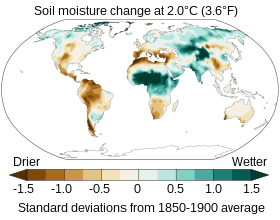
Temperatures in Israel vary widely, especially during the winter. Coastal areas, such as those of Tel Aviv and Haifa, have a typical Mediterranean climate with cool, rainy winters and long, hot summers. The area of Beersheba and the Northern Negev have a semi-arid climate with hot summers, cool winters, and fewer rainy days. The Southern Negev and the Arava areas have a desert climate with very hot, dry summers, and mild winters with few days of rain. The highest temperature in the world outside Africa and North America as of 2021[update], 54 °C (129 °F), was recorded in 1942 in the Tirat Zvi kibbutz in the northern Jordan River valley.[325][326] Mountainous regions can be windy and cold, and areas at elevation of 750 metres (2,460 ft) or more (same elevation as Jerusalem) usually receive at least one snowfall each year.[327] From May to September, rain in Israel is rare.[328][329]
There are four different phytogeographic regions in Israel, due to the country's location between the temperate and tropical zones. For this reason, the flora and fauna are extremely diverse. There are 2,867 known species of plants in Israel. Of these, at least 253 species are introduced and non-native.[330] There are 380 Israeli nature reserves.[331]
With scarce water resources, Israel has developed various water-saving technologies, including drip irrigation.[332][better source needed] The considerable sunlight available for solar energy makes Israel the leading nation in solar energy use per capita—practically every house uses solar panels for water heating.[333] The Israeli Ministry of Environmental Protection has reported that climate change "will have a decisive impact on all areas of life", particularly for vulnerable populations.[334]
Government and politics

Israel has a parliamentary system, proportional representation and universal suffrage. A member of parliament supported by a parliamentary majority becomes the prime minister—usually this is the chair of the largest party. The prime minister is the head of government and of cabinet.[335][336] The president is head of state, with limited and largely ceremonial duties.[335]
Israel is governed by a 120-member parliament, known as the Knesset. Membership of the Knesset is based on proportional representation of political parties,[337][better source needed] with a 3.25% electoral threshold, which in practice has resulted in coalition governments. Residents of Israeli settlements in the West Bank are eligible to vote[338] and after the 2015 election, 10 of the 120 members of the Knesset (8%) were settlers.[339] Parliamentary elections are scheduled every four years, but unstable coalitions or a no-confidence vote can dissolve a government earlier.[40] The first Arab-led party was established in 1988[340] and as of 2022, Arab-led parties hold about 10% of seats.[341] The Basic Law: The Knesset (1958) and its amendments prevent a party list from running for election to the Knesset if its objectives or actions include the "negation of the existence of the State of Israel as the state of the Jewish people".
The Basic Laws of Israel function as an uncodified constitution. In its Basic Laws, Israel defines itself as a Jewish and democratic state, and the nation-state of exclusively the Jewish people.[342] In 2003, the Knesset began to draft an official constitution based on these laws.[311][343]
Israel has no official religion,[344][345][346] but the definition of the state as "Jewish and democratic" creates a strong connection with Judaism. On 19 July 2018, the Knesset passed a Basic Law that characterizes the State of Israel as principally a "Nation State of the Jewish People", and Hebrew as its official language. The bill ascribes, an undefined, "special status" to the Arabic language.[347] The same bill gives Jews a unique right to national self-determination, and views the developing of Jewish settlement in the country as "a national interest", empowering the government to "take steps to encourage, advance and implement this interest."[348]
Legal system
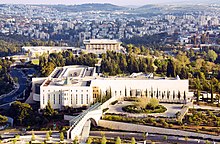
Israel has a three-tier court system. At the lowest level are magistrate courts, situated in most cities across the country. Above them are district courts, serving as both appellate courts and courts of first instance; they are situated in five of Israel's six districts. The third and highest tier is the Supreme Court, located in Jerusalem; it serves a dual role as the highest court of appeals and the High Court of Justice. In the latter role, the Supreme Court rules as a court of first instance, allowing individuals, both citizens and non-citizens, to petition against the decisions of state authorities.[349]
Israel's legal system combines three legal traditions: English common law, civil law, and Jewish law.[311] It is based on the principle of stare decisis (precedent) and is an adversarial system. Court cases are decided by professional judges with no role for juries.[350][better source needed] Marriage and divorce are under the jurisdiction of the religious courts: Jewish, Muslim, Druze, and Christian. The election of judges is carried out by a selection committee chaired by the justice minister (currently Yariv Levin).[351] Israel's Basic Law: Human Dignity and Liberty seeks to defend human rights and liberties in Israel. The United Nations Human Rights Council and Israeli human rights organization Adalah have highlighted that this law does not in fact contain a general provision for equality and non-discrimination.[352][353] As a result of "Enclave law", large portions of Israeli civil law are applied to Israeli settlements and Israeli residents in the occupied territories.[354]
Administrative divisions
The State of Israel is divided into six main administrative districts, known as mehozot (Hebrew: מחוזות; singular: mahoz) – Center, Haifa, Jerusalem, North, South, and Tel Aviv districts, as well as the Judea and Samaria Area in the West Bank. All of the Judea and Samaria Area and parts of the Jerusalem and Northern districts are not recognized internationally as part of Israel. Districts are further divided into fifteen sub-districts known as nafot (Hebrew: נפות; singular: nafa), which are themselves partitioned into fifty natural regions.[355]




